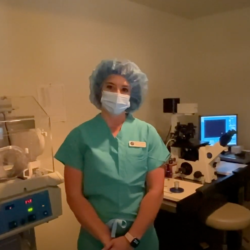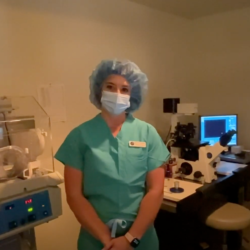
If you are considering In Vitro Fertilization (IVF), you may have heard references to PGD and PGS. Both are types of preimplantation genetic testing (PGT) that are important treatment options available for patients undergoing IVF treatments. Preimplantation Genetic Screening (PGS) and Preimplantation Genetic Diagnosis (PGD) are both performed on cells from embryos in the embryology lab, but they have different purposes and screen for different genetic problems. PGS screens biopsied cells from the embryo for potential genetic abnormalities when there are no known potentially inherited disorders. PGD, on the other hand, uses the same process to detect a specific disorder that has a high probability of being passed down from parents to their offspring.
Although many people having fertility treatment will not need to have either of these types of testing done, PGS or PGD may assist your reproductive endocrinologist in finding healthy embryos to implant in your uterus during your IVF treatment.
What Is PGS and When Is It Used?
The most common reasons for failure of embryos to implant and of miscarriage are chromosomal abnormalities such as having too many or too few chromosomes. PGS, is the genetic screening used to determine if the cells in an embryo have the correct number of chromosomes.
PGS is recommended for patients who are starting IVF who have no known genetic abnormalities, as well as the following patients:
- Women aged 38 or older
- Couples interested in a single embryo transfer
- Women with a history of pregnancy loss or recurrent miscarriages
- Couple with a history of failed IVF/implantation failure
PGS really can be a game-changer because it permits the reproductive endocrinologist to transfer only the healthiest embryos, increasing the chances of successful IVF. Five or six embryos are needed for this test, which can be challenging, especially for older women with decreased ovarian reserve. Some women may require more than one IVF cycle to grow enough embryos for testing.
Although PGS does not test for specific diseases, the procedure does screen for chromosomal abnormalities, such as Down Syndrome. It also identifies chromosomal abnormalities in the embryo, even if there’s no known evidence of a genetic abnormality in either parent.
What Is PGD and When Is It Used?
PGD involves genetic testing of an embryo for a specific gene mutation when one or both biological parents are aware of the existence of a genetic abnormality. This test is important if you or your male partner have a history of genetic diseases in your family and you want to be sure you are not passing it on to a child. In some cases, you may be a carrier for a disease without having the disease yourself.
PGD tests for:
- Translocations of genes (exchange of chromosomal materials or other structural rearrangements), which can cause birth defects, mental retardation, or miscarriage
- Huntington disease
- Marfan syndrome
- Recessive genetic diseases such as cystic fibrosis or Tay-Sachs disease
- Genetic diseases carried on the X chromosome, such as hemophilia or Duchenne muscular dystrophy
- Gender, which allows you to avoid an X-linked genetic disease (mostly boys have those)
PGD is a significantly more complex process than PGS since it examines for individual genes. It is recommended for couples that have a genetic predisposition and/or have any probability of passing down a known genetic abnormality. Any couple with a family history of aneuploidy (abnormal number of chromosomes) which results in miscarriage, birth defects, or Down Syndrome should be screened. Families that have a history of single-gene defects—such as cystic fibrosis, sickle cell anemia, and muscular dystrophy—should also consider PGD testing.
The Next Step in Building Your Family
Both PGS and PGD are utilized to determine genetic abnormalities. In modern IVF approaches at the Fertility Institute, we recommend screening all embryos to ensure better implantation rate and lower rates of miscarriage.



